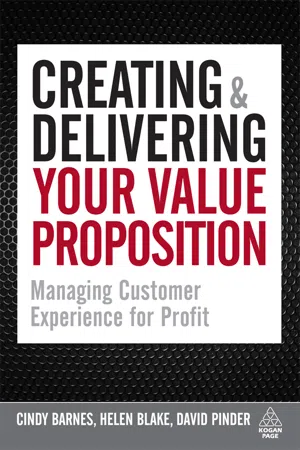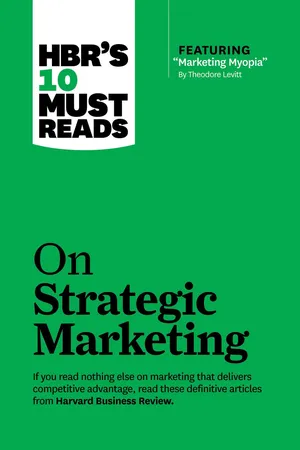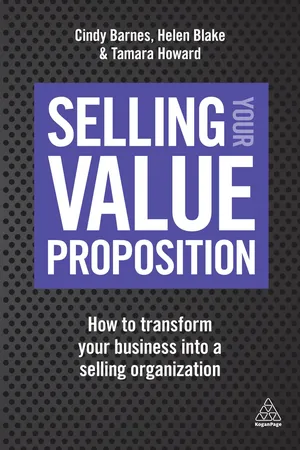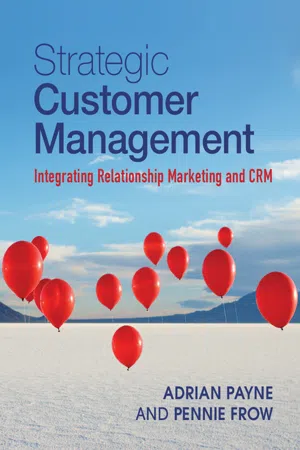Marketing
Value Proposition
A value proposition is a statement that communicates the unique benefits and value that a product or service offers to its customers. It outlines what sets the offering apart from competitors and why it is the best choice for the target audience. A strong value proposition addresses customer needs and pain points, ultimately influencing purchasing decisions.
Written by Perlego with AI-assistance
Related key terms
1 of 5
10 Key excerpts on "Value Proposition"
- eBook - PDF
Infinite Value
Accelerating Profitable Growth Through Value-based Selling
- Mark Davies(Author)
- 2017(Publication Date)
- Bloomsbury Business(Publisher)
As David Ogilvy states: A BRAND is the intangible sum of a product’s attributes: Its name, packaging and price, its reputation and the way it is advertised. Customer value strategy relies on this brand message being expressed and delivered to a finite selection of customers. It is aimed at individual customers. In this instance, the message becomes the customer Value Proposition. This is focused toward one customer and their specific requirements: • A customer Value Proposition summarizes an improved future scenario offered by a supplier to its target customer. • It describes products, services and the relationship ethos that will be provided, and it supports this position with evidence to demonstrate Figure 6.1 Three levels of value hierarchy Corporate (Brand) Divisional/Sector Customer 1. 2. 3. 84 Infinite Value how these value promises will deliver a sustainable competitive performance. To target a specific customer it is better to develop a bespoke customer Value Proposition that builds on the supplier brand story. There are 4 main components of a customer Value Proposition. The opening statement describes a future state that will be received by the customer if the adopt the proposal. This futures state is then supported by details of how the supplier will make this happen, and the evidence that supports why they should be trusted. The final component describes the cost (fee) and its value benefits. This is far more precise and personal value description for the customer and puts them at the centre of the procurement process. The customer offering details all of the components that will be delivered by the supplier to make the Value Proposition promises become a reality. Finally, the customer offering is the ‘nuts and bolts’ of the offering. It is the detail of the offer and describes all of the components that will be delivered by the supplier to the customer. Very often, organizations make the mistake of describing the customer offer as the Value Proposition. - eBook - ePub
Creating and Delivering Your Value Proposition
Managing Customer Experience for Profit
- Cindy Barnes, Helen Blake, David Pinder(Authors)
- 2009(Publication Date)
- Kogan Page(Publisher)
Chapter 13 .To sum it up…A Value Proposition statement is a clear, compelling and credible expression of the experience that a customer will receive from a supplier’s measurably value-creating offering, where Value = Benefits minus Cost. It is not a description of what your organization does for a customer.The broad components of a VP are:- Capability: what you can do for a customer.
- Impact: how that will help the customer to succeed.
- Cost: what the customer must pay for the privilege.
- A Value Proposition must be compelling and believable.
- Value Proposition development needs to be carried out at the top level, market, opportunity and functional levels.
- VPs work because they force focus. The struggle is important: it’s the tool that helps you focus your own business and more reliably win business in any sales situation.
- That’s particularly important in tough economic times because you need to be sure that whatever resources you commit to sales have the best possible chance of winning.
1. Delivering Profitable Value, Michael J. Lanning, Perseus Publishing, 1998.2. Delivering Profitable Value, Michael J. Lanning, Perseus Publishing, 1998.3. Business Market Management – Understanding, creating and delivering value, James C. Anderson and James A. Narus, Pearson Education International, 2004.4. As in any business activity, risk is present at every stage, but it is important to differentiate between operational risk (that is, risk relating to your organization) and customer risk (the risk or risks that a customer may experience).5. Gartner, as reported by Baseline, June 24, 2005.6. - eBook - PDF
- Malcolm McDonald, Ailsa Kolsaker(Authors)
- 2017(Publication Date)
- Red Globe Press(Publisher)
Clearly, successful relationship development through strategic marketing depends on the construction of a manifestly strong and purposeful statement of value that respects the agendas of both parties. The creation of such a Value Proposition by the supplying organization depends first on choosing and prior-itizing the markets and segments in which it wishes to operate. These decisions will be based on the analyses produced in the previous process (defining mar-kets and customer value) and will take into account both the market’s/segment’s 133 CHAPTER 8 – DEFINING MARKETING OBJECTIVES AND STRATEGIES inherent attractiveness and the organization’s actual and potential ability to meet those customers’ needs and expectations. Target market selection will thus also be influenced by the corporate objectives. To understand how all these ele-ments fit together, let us start by looking in some depth at the process of setting marketing objectives and developing marketing strategy. MARKETING OBJECTIVES AND STRATEGIES MARKETING OBJECTIVES Marketing objectives concern both what the organization hopes to receive from each segment in terms of, for example, market share, volume, value or contri-bution and what it hopes to deliver to customers in return. This price/Value Proposition (what the supplier gives/gets and what the customer gives/gets) can be thought of as the four ‘P’s translating to four ‘C’s: P roduct: C onsumer wants and needs P lace: C onvenience (access, availability and distribution) P rice: C ost P romotion: C ommunication For example, ‘consumer wants and needs’ will be met by the ‘product’, as they help to shape product design and development. The customer is concerned with ‘convenience’ of purchase, which influences how the supplying organi-zation will ‘place’ the product in the marketplace. Similarly, the customer is interested in the total ‘cost’ of product purchase and ownership, not just the upfront ‘price’. - eBook - PDF
Value-ology
Aligning sales and marketing to shape and deliver profitable customer value propositions
- Simon Kelly, Paul Johnston, Stacey Danheiser(Authors)
- 2017(Publication Date)
- Palgrave Macmillan(Publisher)
2 Value Propositions: So What Are They? 37 If you embrace this approach then you should be performing a deep level of research into your customers. Through this you can identify their unique challenges and develop company level Value Proposition statements that sig- nal your understanding of how you can help them solve some of the problems they are facing. Given the work that has gone before there should be good alignment between the customers issues, the sector issues and the overall value themes you selected earlier in the process. Going through this exercise will also help you form a view about which of your products and services can help the customer solve each of their prob- lems. You will need to develop Value Propositions for each of these solutions which demonstrate that you understand what performance needles you are moving for the customer, and how you can do it better than your competi- tors. Below we give an example of this type of Value Proposition, inspired by a real Value Proposition adapted from a previous company engagement, and which led to a sale: Example Call Centre Value Proposition Money Bank PLC will be able to improve customer retention by 10 % or $500,000 annually through the ability to handle all incoming calls as a result of implementing an integrated call centre for $300,000. Cost of ownership Customer reteng415on Improving closure rates Reducg415on in staff costs Fig. 2.2 Value Propositions differ by C Level Officer 38 Value-ology By September 2017, the company will be able to demonstrate the delivery of value by improved customer retention and revenue growth. We have included some templates at the end of this chapter to help with this approach. Exercise 4: So how MUSICAL is the Value Proposition in Fig. 2.2? How could you improve it? Write down your thoughts and compare them with ours. - eBook - ePub
- Harvard Business Review, Clayton M. Christensen, Theordore Levitt, Philip Kotler, Fred Reichheld(Authors)
- 2013(Publication Date)
- Harvard Business Review Press(Publisher)
If you sell products to other companies, you know how hard it’s become to win their business. Your customers—pressured to control costs—seem to care only about price. But if you lower prices to stimulate sales, your profits shrink.So how can you persuade your business customers to pay the premium prices your offerings deserve? Craft a compelling customer Value Proposition . Research potential customers’ enterprises, identifying their unique requirements. Then explain how your offerings outmatch your rivals’ on the criteria that matter most to customers. Document the cost savings and profits your products deliver to existing customers—and will deliver to new customers.The payoff? You help your customers slash costs—while generating profitable growth for yourself. One company that manufactured resins used in exterior paints discovered this firsthand. By researching the needs of commercial painting contractors—a key customer segment—the company learned that labor constituted the lion’s share of contractors’ costs, while paint made up just 15% of costs. Armed with this insight, the resin maker emphasized that its product dried so fast that contractors could apply two coats in one day—substantially lowering labor costs. Customers snapped up the product—and happily shelled out a 40% price premium for it.Three Kinds of Value Propositions
We have classified the ways that suppliers use the term “Value Proposition” into three types: all benefits, favorable points of difference, and resonating focus. (See the exhibit “Which alternative conveys value to customers? ”)All benefits
Our research indicates that most managers, when asked to construct a customer Value Proposition, simply list all the benefits they believe that their offering might deliver to target customers. The more they can think of, the better. This approach requires the least knowledge about customers and competitors and, thus, the least amount of work to construct. However, its relative simplicity has a major potential drawback: benefit assertion - eBook - ePub
A Practitioner's Guide to Account-Based Marketing
Accelerating Growth in Strategic Accounts
- Bev Burgess, Dave Munn(Authors)
- 2021(Publication Date)
- Kogan Page(Publisher)
09Developing targeted Value Propositions
What is a Value Proposition?
While Step 2 of the ABM process focuses on describing the plays you could take into an account in terms of the tangible and intangible features of your solution to a client’s problem, this fourth step in the process is about building targeted messages for the DMU identified in Step 3 to communicate the value your solution will deliver. This is represented graphically in Figure 9.1 .The most successful Value Proposition starts with a customer’s business issue, in their words and from their perspective. In ABM terms, this is the imperative that is impacting them and the initiative they are taking, or could take, in response. It describes your solution to their issue (your play), the particular benefits your solution provides over competitor solutions and the business outcomes they should expect by implementing your solution through a combination of benefits and price.Figure 9.1 Play, Value Proposition, and elevator pitchValue Propositions should be simple, clear, easy-to-absorb statements, adaptable to specific buyers, credible and backed up by proof points. Wherever possible, they should be financially quantified when used in an ABM context. They should encapsulate the reason that your potential buyers should purchase your company’s product, service or solution rather than anyone else’s. And, in these post-pandemic times, communicating value that resonates with a customer is more than a goal. It is increasingly a matter of survival.A note on value
Remember, value is a subjective judgement. It is the client’s assessment of benefits minus costs: benefits may be tangible, such as a percentage reduction in operating costs by using a technology solution, or intangible, such as minimizing the risk of changing outsourcing supplier by staying with the incumbent. Wherever possible, if your Value Proposition offers tangible benefits to a client, you should try to quantify those benefits and show where other clients have received them from you in the past if you can. - eBook - ePub
Selling Your Value Proposition
How to Transform Your Business into a Selling Organization
- Cindy Barnes, Helen Blake, Tamara Howard(Authors)
- 2017(Publication Date)
- Kogan Page(Publisher)
02Why businesses need a Value Proposition
The good news is that many of the businesses suffering from the symptoms discussed in Chapter 1 have made the changes necessary to adapt to the new market conditions. It is important to note that these changes really are possible. Not all companies are in distress. Those that are thriving have taken steps while business is good and invested in new strategies and approaches to their marketplace.A road map for success
So what is it that these successful businesses are doing? How are they weathering the changing market? The answer is that they are engaging with their customers and studying customer behaviours, new buying patterns and trends, and then adjusting their entire business accordingly . The fast-food company McDonald’s, following the resignation of its CEO in 2015, hired a new leader, Steve Easterbrook, who revealed his new strategy for the business. He is quoted as saying that he ‘planned to strip away layers of management, focus more on listening to customers, and act faster to adapt to consumers’ changing tastes’ (Peterson, 2015). Winning businesses will adapt while those that do not will find their financial performance slowly declining.For declining businesses, the first step is to acknowledge that there is a problem. Once this is acknowledged, the next step is to follow a more customer-centric road map to success. By shifting the focus to the customer, a company-wide Value Proposition provides the foundation for business resilience and growth. This approach follows the:Passage contains an image
1st Law of Value Proposition Selling: the whole company plays a role in supporting the sales process.Selling should be a team sport. Each business area and function has a role to play and all parts must be orchestrated towards a desired outcome. This approach does not mean that everyone goes out and sells directly to customers. But it does mean that each person knows what he or she can do to support and promote the company. Most importantly, everyone must believe in the company’s value to customers and the problems they can solve. If this belief is not genuine, customers will sense the insincerity and begin to question the honesty of the business. - eBook - ePub
Executive Coaching
Building and Managing Your Professional Practice
- Lewis R. Stern(Author)
- 2009(Publication Date)
- Wiley(Publisher)
- Middle managers
- Project managers
- Technical leaders
Other Market Characteristics and Situations
- Start-ups
- Highly competitive markets
- Mergers and acquisitions
- Organizations in crisis
- Financial recovery situations
- Downsizing situations
- Major organizational change
YOUR PROFESSIONAL EXECUTIVE COACHING Value Proposition
You have asked yourself and hopefully answered the questions about your personal goals, the special value you will offer your clients, services to provide, and market segments on which to focus. Your answers to these four basic questions are the building blocks for your true Value Proposition as a professional executive coach. Now you must assemble these blocks into a proposition that will appeal to your target markets.Your proposition may take many forms as described next. You can use all of these marketing forms and materials to bring your Value Proposition to life and attract potential clients. Your goal in formulating a Value Proposition is to communicate to prospective clients that you can best meet their needs, not to entice them to select you even if another coach would serve them better. In fact, you have an obligation to refer a potential client to other coaches or consultants when you know it would be to the client's benefit. By sharing your Value Proposition with other professionals, you will be in a position to refer prospects and receive referrals yourself. - No longer available |Learn more
Marketing In Creative Industries
Value, Experience and Creativity
- Gabriele Troilo(Author)
- 2017(Publication Date)
- Red Globe Press(Publisher)
In other words, the organization formulates the Value Proposition to offer to the market by analyzing needs expressed (more or less ambiguously) by current and potential customers. But the questions are how to decide which strategic approach to adopt, which markets to focus on, and where to offer Value Propositions. Obviously there are several things to consider, but the market lifecycle model helps find the answers. During the introduction stage, the market potential gap is sizeable. Many potential customers have yet to make their first purchases, and there are only a few organiza-tions offering products. This stage is when the most interesting opportunities can be found in the potential market as opposed to the current one, which is still small. In fact, the current market may be so small that if competitors were to focus exclusively on present customers, they’d be battling over negligible sales, and 188 Marketing in Creative Industries this would probably prevent the market from progress-ing to the next stage. As for the growth stage, the current market is now reaching a size that makes it attractive for organiza-tions that compete here, but the market potential gap is still interesting enough to warrant ad hoc strategies. This is the time to pursue a dual strategy, center-ing in part on activating the potential market with specially developed Value Propositions, and in part consolidating relationships within the current market via propositions that follow the evolution of customer expectations. The maturity stage sees a shrinking market potential gap, so at this point organizations have to secure a strong competitive position and a solid base of loyal customers who guarantee stable sales. This means systematically refining current Value Propositions, and at the same time attempting to create innovative ones to trigger a new growth stage. But under these market conditions, the biggest growth opportunities are prob-ably not inside the market. - eBook - PDF
Strategic Customer Management
Integrating Relationship Marketing and CRM
- Adrian Payne, Pennie Frow(Authors)
- 2013(Publication Date)
- Cambridge University Press(Publisher)
In this chapter we focus on how the enterprise can create and deliver value to its customers. Later, as part of our discussion of CRM in Chapter 8 , we discuss how the enterprise can successfully manage relationships to maximise the value it receives from its customers. Unfortunately, the emphasis in many companies is on this latter element of value. To these companies, customer value means: How much money can we extract from the customer? How can we sell them more of the existing products and services they are buying? How can we cross-sell them new products and services? Yet in today ’ s competitive arena, where a growing number of businesses vie for a greater share of a fi nite customer pool, it has become imperative to fi rst consider customer value in terms of customer bene fi t and how we can ensure the customer Value Proposition is relevant and attractive and that the customer experience is consistently positive. This is at the heart of building relationships. The value the customer receives The value the customer receives from the supplier organisation is the total package of bene fi ts, or added values, that enhance the core product. As pointed out by Theodore Levitt, competition exists not between what companies produce in their factories but between ‘ what they add to their factory output in the form of packaging, services, advertising, customer advice, fi nancing, delivery arrangements, warehousing, and other things that people value ’ . 1 The value the customer attributes to these bene fi ts is in proportion to the perceived ability of the offer to solve whatever customer problem prompted the purchase. In this section of the chapter we fi rst review the nature of what the customer buys by explaining how the core and augmented product, relationships and brands all contribute to an enterprise ’ s Value Proposition. In the next section we then examine the nature of the Value Proposition and the value assessment.
Index pages curate the most relevant extracts from our library of academic textbooks. They’ve been created using an in-house natural language model (NLM), each adding context and meaning to key research topics.









